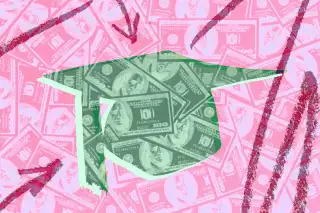Financial Aid Recipients From These Colleges Can Now Claim Part of $284 Million Settlement

Financial aid recipients who attended 10 U.S. colleges can submit claims for part of a $284 million settlement payout in a class action lawsuit over alleged price fixing.
The plaintiffs alleged in a January 2022 complaint that these colleges "violated federal antitrust laws by agreeing regarding principles, formulas, and methods of determining financial aid" and "provided less need-based financial aid than they would have provided had there been full and fair competition," according to the settlement website.
A total of 17 universities are defendants in the litigation, and more settlements are possible from the other seven colleges. (Students from those remaining seven schools can submit claims along with everyone else through a claim form that became available on Sept. 13, but it’s not clear how much their universities may agree to pay.)
The "elite" colleges that were named as defendants all primarily had need-blind admissions, a term used when colleges promise to admit students regardless of their financial need. They also were at some point part of an association called the 568 Presidents Group. The group came together in 1998 and several years later created a methodology for assessing an applicant's ability to pay, which was used to determine financial aid. It was dissolved in 2022, after the lawsuit was filed.
The group described its aims benevolently, and its website said the goal was to "reduce much of the variance in need analysis results," however, the colleges were effectively eliminating competition on financial aid, according to the antitrust lawsuit.
Here are the 10 settlements that already have final approval:
- University of Chicago: $13.5 million
- Emory University: $18.5 million
- Yale University: $18.5 million
- Brown University: $19.5 million
- Columbia University: $24 million
- Duke University: $24 million
- Dartmouth College: $33.75 million
- Rice University: $33.75 million
- Northwestern University: $43.5 million
- Vanderbilt University: $55 million
The universities continue to deny all allegations of wrongdoing and a settlement isn't an admission of guilt. "Defendants have asserted that they had no agreement with other Universities regarding their financial aid policies" and "that each University’s financial aid policy was lawful and designed to promote socio-economic diversity at its institution by enhancing financial awards," according to the settlement website.
What is the financial aid lawsuit about?
The case involves allegations of price fixing by 17 colleges in the financial aid process.
U.S. colleges are exempt from a key antitrust law if they have need-blind admissions. But the lawsuit alleges that many of the defendant colleges never truly did, citing instances where wealthy students like legacy applicants were favored. Colleges also allegedly favored full-paying applicants when taking students off waitlists.
Therefore, the suit argues the defendants shouldn't have been allowed to work together to create uniform standards for assessing need. This alleged collusion limited competition on financial aid offers "driving down aid packages and thereby driving up the net price of attendance for aid-eligible students."
How much is the settlement?
In an email this week notifying recipients about the settlement, the claims administrator estimated that the average claimant could get about $2,000. That's based on an assumption that half of the 200,000 people who are estimated to be eligible actually submit claims on time.
The notice said the payouts will depend on the average net price of the college the claimant attended and the duration of attendance. The size of your particular alma mater's settlement is not a factor — the payments will come from one combined settlement fund.
Who is eligible to claim money from this settlement?
There are several criteria you must satisfy to receive a settlement payment. According to the website, the settlement includes citizens or permanent residents who were full-time undergraduate students during the “class period” and received need-based financial aid from one of the defendants. You are not eligible if your tuition and room and board were fully covered by financial aid or merit aid.
For most of the 17 colleges, financial aid recipients may be eligible to submit a claim if they were enrolled at some point between fall 2003 and February 2024. (The “class period” is shorter for Brown, Dartmouth, Emory, CalTech and Johns Hopkins. Details are available here.)
How to claim the financial aid settlement?
The simplest way to submit a claim for the settlement is to complete the form online.
If you received a personalized notice about the settlement, you should have a notice ID and a confirmation code in your email. Enter that information on the claim form, and proceed to the next page which asks for information like your name and address, the college you attended and your financial aid details. The form also asks for you to upload a transcript, diploma, student ID or other proof of attendance.
Lastly, select how you'd like to be paid: Options include Venmo, Zelle, PayPal, Mastercard and direct deposit.
If you did not receive a personalized notice of the settlement, there's still an option to submit a claim form online. The deadline to submit the form is Dec. 17.
More from Money:
Student Loan Borrowers to Get Relief Checks After $120 Million Navient Settlement